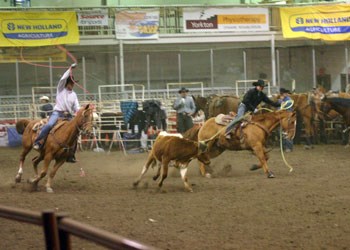While rodeo continues to be an event practiced by working cowboys on farms and ranches, it is also fast becoming a competition for urban cowboys in several of the events. One such competitor is Dustin Cromarty of Regina. Cromarty does have a tenuous rural tie in that his family has an acerage near Lumsden. He was in Yorkton taking part in the team roping competition as the header.
Team roping is an efficient way to treat cattle out in the pasture, Cromarty opens. One cowboy, the header, will put a rope around the steer's head. The other rider ropes the back feet, then would lay the animal down on the ground.
"Then you can go up and treat them and doctor them or check them out and ear tag them," he explains. Initially that was the main way to doctor cattle because they didn't have squeeze chutes or coral pens. They'd just do the job out on the open prairie, he says. Team roping is one of the earliest rodeo competitions, Cromarty suggests.
The 29 year-old who started team roping at 13 years has been at it for about 16 years. He initially started showing horses and competing in gymkhana. Team roping evolved as his favorite competition.
Cromarty has had a busy rodeo season this year. He competed at 39 rodeos. He could have attended another 10, he says. In addition he competed in about 15 to 20 team roping jackpot competitions as well. This season, which saw him qualify for the Canadian Cowboy Association (CCA) finals for the first time, has been very good. The CCA finals which take place in Regina take the top 11 competitors. "This is my first year going to that many rodeos and competing as well as I have, " he says.
He enjoys the social aspect of team roping. "It's a lot more high octane than showing. It's easy to get into and a lot of fun," Cromarty offers.
At Harvest Showdown there were three different categories. Every roper has a number reflecting their ability to rope. There was a nine, 11 and an 'open' class. The two ropers numbers combined will equal a nine or lower, an 11 or lower or an open which includes anybody, Cromarty continues. The 'open' class ropers are the best quality ropers who should have the fastest runs.
On each run, the steer will have a head start. As it begins its run it breaks a 'barrier line' which snaps back to signals the cowboys to start their roping run. At Harvest Showdown the barrier line used an electric timing device. As the run starts, occasionally a buzz signals that the ropers broke out before giving the steer the required head start which earns a 10 second penalty to be added to the competitors' time. No buzz indicted a clean start.
The object of the competition is to rope both the head and hind legs to immobilize the steer. The header must rope the animal's head while the heeler must rope both hind feet or legs. Roping one leg adds a five second time penalty while missing entirely results in a failed run with no time awarded.
Cromarty has been attending the Yorkton rodeo for about 10 years. Yorkton does an excellent job staging the rodeo and all the related Harvest Showdown events, he says. He appreciates both the people who put on the Showdown and the facility which makes it a great event.




